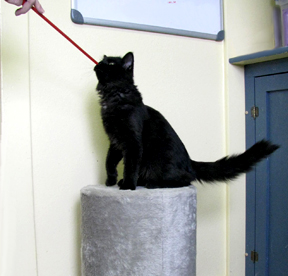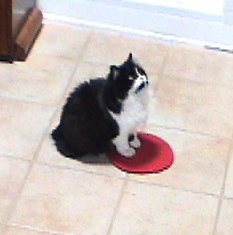The word training can rub people the wrong way, especially cat people. Cat people know instinctively that force doesn’t work on a cat. Clicker training isn’t forceful, it’s joyful. It really should be called Clicker Play because that’s how your cat will think of it. We’ve never seen a cat who understands the contract not want to play the game.
Clicker training sets up a contract between you and the cat: if they do certain things, they get a click then a treat. Cat translation: if I do certain things, I can train my human to click then treat…how cool is that?!
The BIG TWO Rules:
1. The click marks the behavior, telling them exactly what you’re paying for. But remember: it also stops the behavior.
2. If you click, you must treat: that’s the contract. Most dogs are hardwired to love praise & pets, but cats usually need food to pay attention to the lesson. The click goes deeply & quickly into the brain–just like fear only joy–and the treat makes it stick.
How cats differ from dogs:
The treat must be valuable. For many cats, the most valuable treat is probably a lick of their favorite wet food off a spoon or from your hand or maybe bits of tuna or chicken. Commercial treats are very handy, but most cats are indifferent to them unless raised with a certain type. They’re also usually way too big. Break them up into tiny bits and use as little treat as you can get away with.
Train in several small sessions. Cat tummies are usually smaller than dogs and they lose interest when full.
How to start:
First, Charge the Clicker. This just means pairing the click with a treat in the cat’s mind. Feed the cat the treat a few times (not more than 6-8) while clicking as the cat is eating (C/T or Click/Treat). Very soon the cat will start to anticipate the wonderful thing that’s about to happen when you click.
Never ever teach a cat to Sit as its first behavior. Animals will default to their first learned behavior. Cats are hardwired to sit very still while hunting, so if you teach a Sit, you’ll end up with a cat who thinks you’re rewarding it for not moving. Always teach a prop behavior, like Target or Mat, first so you can take away the prop.

Next, teach Target. Find a small stick, like a long chopstick or end of a cat teaser. Place the stick in front of the cat. Most adults will naturally lean to sniff the stick. The instant you have nose to stick contact, click. Try to treat within 2 seconds or less. If you hold the clicker and a few treats in the same hand, you’ll have less risk of intimidating some cats with a click in the ear. You don’t want the click to be a scary thing.
Some cats, especially kittens, will want to play with the stick. This is OK for a time or two, but you’ll need to fade this behavior quickly by not rewarding it and wait for the nose to touch the stick instead. The paw touches will fade if they’re not rewarded, while the nose touches will increase.
Target is especially useful for getting cats to move where you want them to go of their own choice. Anyone who’s ever tried to force a cat to go somewhere it doesn’t want to will appreciate this.

Next, teach Go to Mat. Pick a small flat mat like a large trivet, mouse pad or washcloth, but make sure it’s something you like because you’ll likely be using this for a long time.
Place the mat in front of the cat. Wait for the cat to step on the mat by itself. If it shows little interest, walk around with the mat between you and the cat, calling its name, and watch for that first step on the mat. The second the paw touches the mat, click then feed the treat away from the mat. You want the cat to choose to go to the mat, so don’t feed it on the mat at first. When the cat is reliably touching the mat, up the ante by not C/T until the cat touches with 2 feet, then C/T for a few times. When that’s reliable, again stop C/T until you get 3 feet, then 4. Congratulations…you’ve just learned how to shape a behavior!
If your ultimate goal is for the cat to sit on the mat, reward him on it once he’s doing that. Then use your Target to reward him for moving away. When he chooses to go sit on the mat, reward him again. Keep repeating this until he’s choosing to go sit on the mat 8 times out of 10. When he’s doing that, start adding your verbal command (Go to mat! or just Mat!) as he’s sitting on the mat.
If your ultimate goal is for the cat to lie down on the mat, you’ll have to shape small steps toward that or wait until he gets bored enough to lie down. The second he does, C/T.
End the session by saying Release! and slipping the mat from under the cat. Put the mat away till next time.
You’ve just learned how to both capture and shape other behaviors. Both these behaviors are the foundation for many more. Find out more here or grab yourself a book on Clicker Training cats and let the games begin!

Deprecated: Function get_magic_quotes_gpc() is deprecated in /home2/happyca6/public_html/staging/wp-includes/formatting.php on line 4387
Deprecated: Function get_magic_quotes_gpc() is deprecated in /home2/happyca6/public_html/staging/wp-includes/formatting.php on line 4387
Deprecated: Function get_magic_quotes_gpc() is deprecated in /home2/happyca6/public_html/staging/wp-includes/formatting.php on line 4387